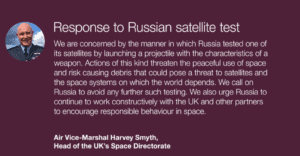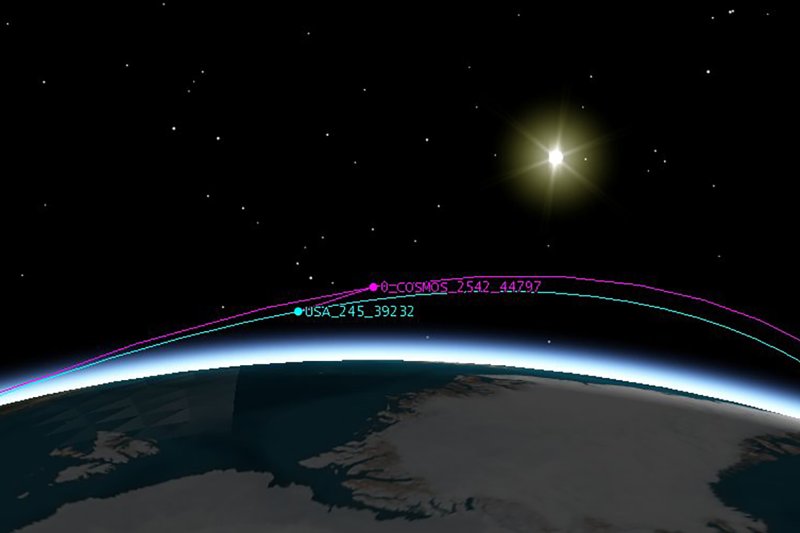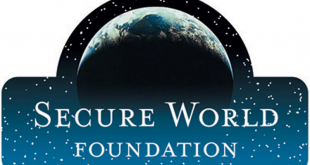As part of the partnership between SpaceWatch.Global and Project Ploughshares, we have been granted permission to publish selected articles and texts. This is Part 1 of “Did Russia Test a Weapon in Space? What the question and the answer tell us about the security of outer space”, originally published 30 July 2020 in Ploughshares Spotlight, July 2020.
by Jessica West, Research contributed by Chris Earle
What happened on July 15?
On July 23, 2020, the United States Space Command Public Affairs Office released information claiming that on July 15, Russia “injected a new object [Object 45915] into orbit from Cosmos 2543” and “released this object in proximity to another Russian satellite.” U.S. Space Command describes this action as a non-destructive co-orbital (space-based) anti-satellite weapon (ASAT) test in close proximity to another Russian satellite.

Dr. Jonathan McDowell, an astrophysicist as Harvard University, calculated that the object was released at “a fairly high relative velocity” compared to its host satellite. Public orbital information indicates that it was ejected at 700 kilometres/hour—a higher speed than would be expected if it were merely “released” into space. Because of the speed, analyst Brian Weeden of Secure World Foundation tweeted, “That’s a projectile being fired, not a satellite deployment.” British Air Vice-Marshal Harvey Smyth posted a similar tweet.

However, the Russian Ministry of Defence stated that, on July 15, “a small space vehicle … inspected one of the national satellites from a close distance using special equipment” that “provided valuable information about the object that was inspected.” This claim makes the object out to be part of a satellite-servicing or inspection capability.
What do we know about Cosmos 2543?
According to information on RussianSpaceWeb.com, Cosmos 2543 is a Russian subsatellite released into orbit on December 6, 2019 from Cosmos 2542, a military satellite launched on November 25, 2019. The Russian Ministry of Defense described 2542 in terms that have become associated with “inspector” satellites, claiming that it is “based on a standard platform which can perform monitoring of the condition of Russian satellites.” Both 2542 and 2543 are registered with the United Nations under the terms of the Registration Convention, as “intended for assignments on behalf of the Ministry of Defense of the Russian Federation.”
Before this event, amateur satellite observers noted significant orbital movements by both Cosmos 2543 and parent satellite Cosmos 2542, with the latter appearing to shadow U.S. reconnaissance satellite USA 254. The United States publicly raised concerns about the activities of these satellites and similar spacecraft.
After trailing the U.S. military satellite, in June 2020 Cosmos 2543 maneuvered again, this time closely approaching Cosmos 2535, launched in 2019, which the Russian Ministry of Defence later described as a participant in the July 15 satellite-servicing experiment. It is at this point that the suspected projectile was released.

How unusual was the event of July 15?
The speed of the object released by Cosmos 2543 clearly stands out. The persistent shadowing of USA 254, which took place over months, was unusual, if not unheard of. The combination of this activity with the unusual velocity of the object released on July 15 led the U.S. Space Command to claim that the “satellite behaviors were inconsistent with their stated mission and that these satellites displayed characteristics of a space-based weapon.” It contends that the July 15 event was the second of a two-part test of a single system capable of closely approaching a foreign target and then releasing a kinetic weapon. Government officials from the United Kingdom came to the same conclusion.
A similar sequence of events involving Russian military satellites occurred in August 2017. The Russian Ministry of Defence described a satellite launched in June 2017 as “a space platform which can carry different variants of payloads” and claimed that it had released a subsatellite “intended for the inspection of the condition of a Russian satellite.” The subsatellite later released a third satellite, which was officially designated Cosmos 2523. The U.S. military calls these satellites “Russian dolls,” which are engaged in close proximity operations, but not with foreign satellites. Recently, public information has been released that suggests that this third satellite was an ejected “projectile,” although with a considerably slower velocity than the object released in July 2020. As in 2020, the United States raised public concerns, although with fewer details.
Since 2013, the Russian military has launched a series of so-called inspector satellites that have reportedly “performed extensive orbital maneuvers” and “hosted technological experiments,” often with other Russian military satellites. Russian satellite Olymp-K (registered with the UN as Luch) raised concerns over its close approaches to U.S. commercial communications satellites and military satellites operated by France and Italy.
In general, it can be said that, while most satellites travel in known, predictable orbits a safe distance from others, in recent years, some satellites have been involved in non-traditional space activities, including close approaches for purported inspection or servicing purposes and the release of subsatellites. Some of this activity is linked to new capabilities such as on-orbit satellite inspection and servicing, sometimes with commercial operators. Most involves military actors, raising threat of harmful applications.
What related activities are happening in space?
The U.S. Space Command and intelligence units have previously accused Russia of conducting non-destructive tests using ground-based anti-missile systems as recently as April 2020. Similar tests, both destructive and non-destructive, have been conducted by China, the United States, and India.
Additional open-source reports suggest that Russia has resumed work on several different ASAT systems, including a co-orbital capability that could function in tandem with a space-based Space Situational Awareness (SSA) program. (Officially, Russia suspended its ASAT program in 1993, 50 years after it was begun by the Soviet Union.) Many capabilities have benign or less aggressive functions, such as space-based satellite servicing and space-based surveillance or inspection of satellites.
Russia is not alone in developing new, mysterious capabilities that could have counterspace applications. Among other countries, the United States has tested a variety of close-approach and rendezvous capabilities in recent years. The U.S. military openly operates six Geosynchronous Space Situational Awareness Program satellites that have the capability to perform rendezvous and proximity operations (RPO) with non-cooperative satellites and to manoeuvre widely to perform what is described as space-based SSA or a “neighbourhood watch” function. Further experiments are being conducted by the Mycroft satellites.
China first demonstrated RPO capabilities in 2008. Recent examples include the Shijian 15 and Shijian 17 satellites; the latter has engaged in extensive manoeuvres. There is no public information that they have approached foreign satellites. However, a review of data published by Secure World Foundation on such activities by all space actors suggests that the extent of Russia’s military RPO behaviour stands out. So does its secrecy.
Both Russia and the US have “space platform” technology that allows for launching additional payloads. The U.S. military has launched an Evolved Expendable Launch Vehicle Secondary Payload Adapter Augmented Geosynchronous Laboratory Experiment (EAGLE) that consists of a main satellite that has been modified to carry up to five subsatellites into space at once, but these deployments are disclosed in advance. It is also connected to servicing and inspection capabilities. However, in 2019, the U.S. X-37B spaceplane released three small, undisclosed satellites that have not been registered with the United Nations.
Russian space platforms consistently involve layers of secrecy. Sub payloads are often spotted by observers and catalogued well in advance of their acknowledgement by officials. This was the case on July 15th.
Where does information about orbital events come from?
Basic orbital information about the position of objects in Earth orbit is published by the U.S. 18th Space Control Squadron based on data collected by its Space Surveillance Network. This information is available to registered users on the Space-Track.org website; the U.S. Space Command referenced this site in its July 23 statement.
Other national and commercial actors maintain similar, non-public databases. Victoria Samson of Secure World Foundation notes that the incident of July 15 had been observed and discussed by the amateur satellite-observation community before it was made public.
Part 2 of “Did Russia Test a Weapon in Space? What the question and the answer tell us about the security of outer space”, originally published 30 July 2020 in Ploughshares Spotlight, July 2020 will be published tomorrow.
 SpaceWatch.Global An independent perspective on space
SpaceWatch.Global An independent perspective on space




